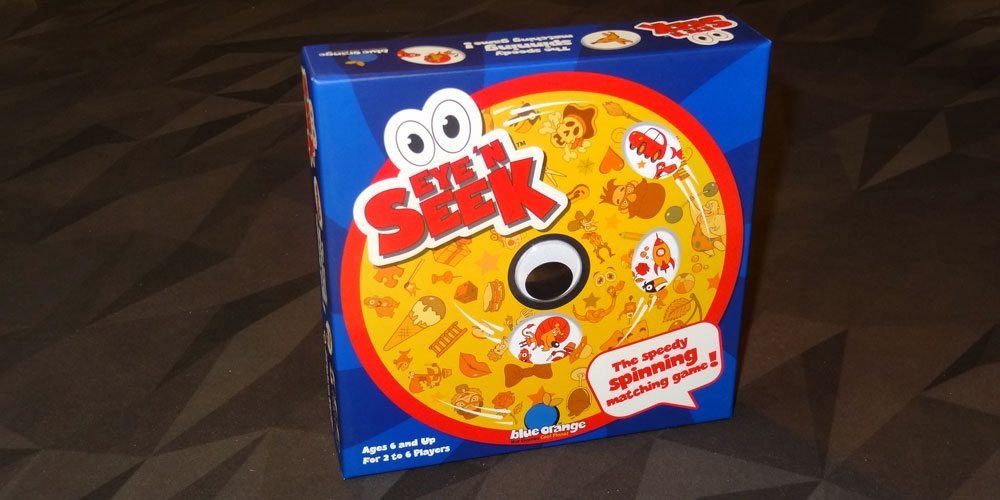
Blue Orange Games is the publisher of Spot It!, a game of speedy observation. There are now many different flavors of Spot It! available, and it’s a popular game especially for younger kids. Blue Orange has a few more games now involving quick inspections, and I’ve gotten to try a few of them recently. Today’s title: Eye ‘N Seek.
At a glance: Eye ‘N Seek is for 2 to 6 players, ages 6 and up, and takes about 10 minutes to play. It retails for $13.99 and is available online and in many major retailers and game stores. The game primarily requires quick searching skills, and you have to be able to spin the dial quickly as well.
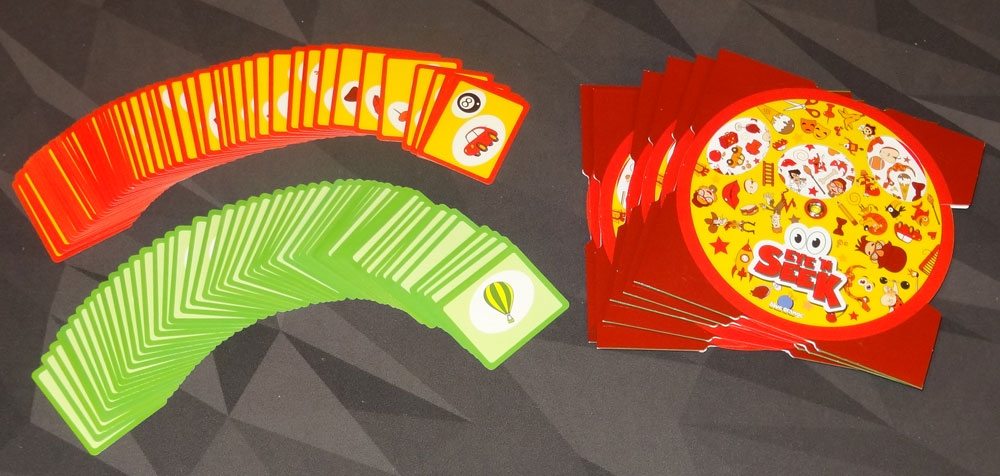
Components
- 6 picture wheels
- 100 picture cards
- 1 giant googly eye on the box cover
Okay, that last bit isn’t really a game component, but it’s worth mentioning that the box cover has a huge googly eye right in the center of it, which is half-cute, half-creepy.
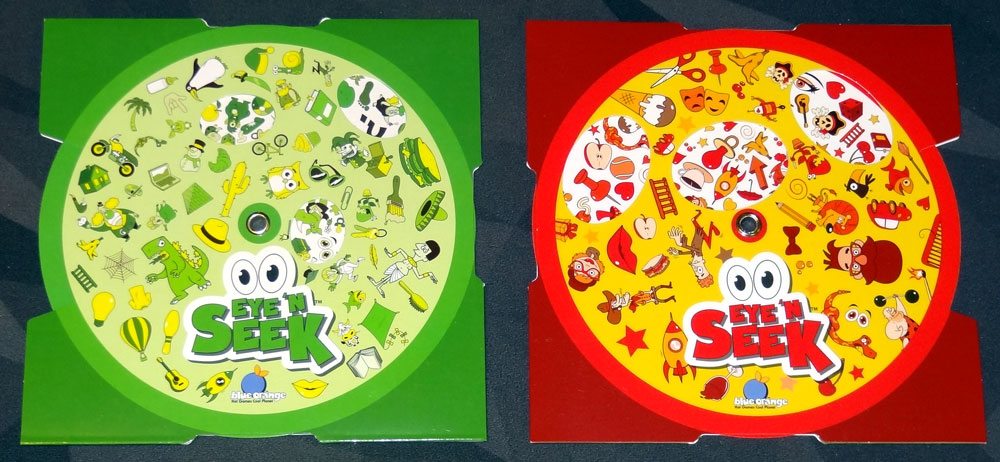
The picture wheel is a cardstock disc in a sort of envelope, with a rivet in the center so you can spin the disc inside the envelope. Each side of the envelope has three windows cut into it so that you can see a portion of the disc, which is covered with a random assortment of images. The disc and envelope are double-sided, green on one side and red on the other, and they have different images. The windows on the red side are larger, and two of the windows are on the edge of the rim so the same images can appear in either of the two windows. The windows on the green side don’t have any overlap.
The disc extends out of the envelope just on one edge, and I didn’t find it hard to spin quickly, but my 3-year-old (admittedly younger than the age recommendation) had trouble gripping just the disc and not grabbing the envelope along with it. It might have been nice to have the edge of the disc be ridged or notched instead of smooth just to make it just a little easier to spin.
The picture cards are small cards in an non-standard size, and they’re double-sided so there are different images on either side. The green deck has one image per side, and the red deck has two images per side.
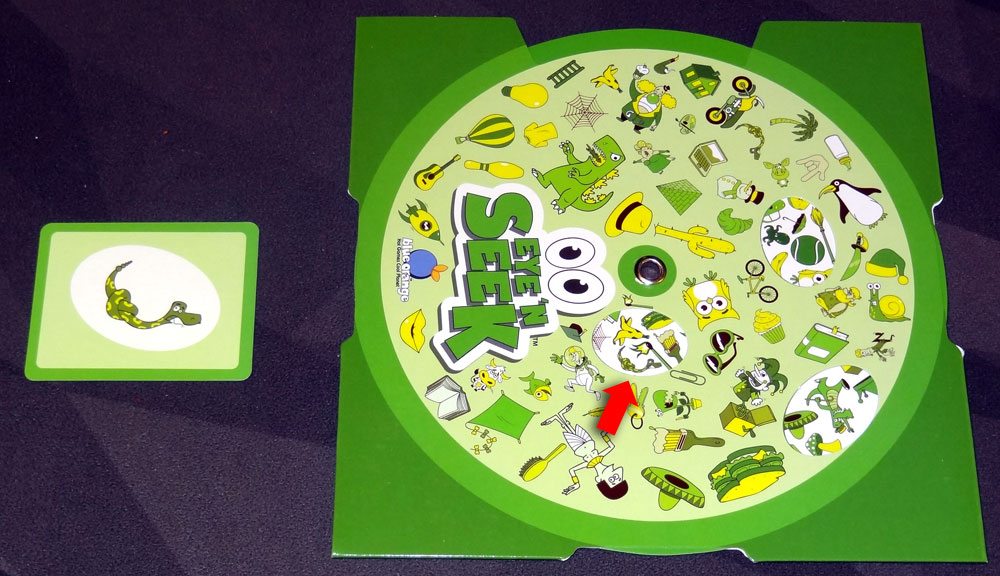
How to Play
The goal of the game is to score the most points by finding the right images quickly.
To set up, you use 18 cards—either green, red, or a mix of both, depending on the desired difficulty level.
To play, flip over the top card of the deck, and then every player simultaneously looks for the matching image by spinning their disc and looking at the windows. On the red cards, you must find both images displayed simultaneously—they may be in the same window or two different windows.
Whoever finds the images first gets the card as a point. The player with the most points when the deck runs out is the winner.
There are several variations, too:
Last One Standing: Whoever is the last to find the image takes the card, and the player with the fewest cards at the end of the game wins.
In Line: Six cards are lined up on the table at a time, and everyone races to find the correct images in order. Whenever somebody finds an image, they grab the card and then play moves to the next card. When all 6 are gone, lay out 6 more (and continue until you’ve used all 18 cards total). The player with the most cards wins.
Out Loud (at least 3 players): One player is the leader, who looks at the card and describes it without naming it, and other players race to find the image. The player who finds the image gets the card and becomes the next leader. First player to 5 points wins.
Initials (3 or more players): Similar to “Out Loud,” except that the leader gets to choose a picture, and then tells the other players the first letter of the image. Other players have to find any image that starts with the same letter.
Rhymes (3 or more players): Same as “Initials,” except that the leader gives a hint that rhymes with the image they’ve chosen.
The Verdict
Eye ‘N Seek makes the standard seek-and-find game into a little more of a hunt, since you can only see a portion of the full picture at any given time. The fact that the envelope for the picture wheel is covered in images (which don’t count) just makes it a little more jumbled and tricky. I like the fact that there are three windows to look at, because you never know which of the three windows your target will appear in. You can try looking at one window at a time and just spinning faster, or else slowing down a bit so you can scan all three windows at once.
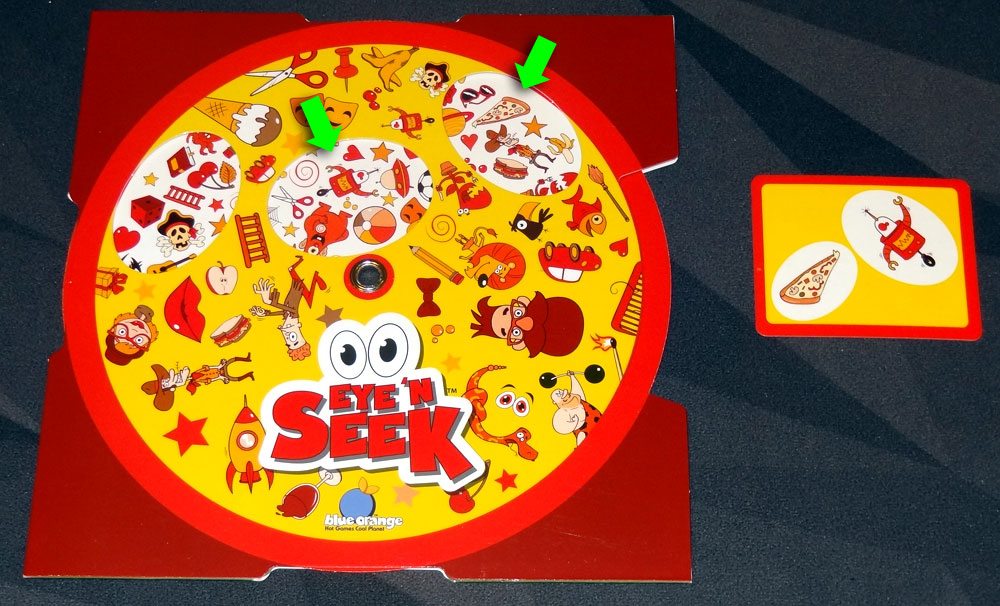
I found that I preferred the red cards, where you have two images to find, because it presented a little more of a challenge. In particular, because two of the windows overlap in which images they can show, it can be extra tricky when you find one of the two. For instance, in the image above, if I turned the dial so the pizza was in the left-most window, the robot would no longer be visible. Of course, for younger players, the green side may be challenging enough.
Sometimes when you flip the next card, you’ll see that the next target image is already visible through the window—usually I end up throwing that card out and choosing a new one, but you can also have everyone spin their wheel randomly a little bit before flipping the next card.
As you can see, the game is fairly simple—players who are skilled at Where’s Waldo? are going to excel at it, and those who have trouble finding tiny things won’t like it as much. I do like that there are variations included in the rules, but probably the most interesting one is the “In Line” variation, because it allows for some strategizing even if you’re a weaker player. You could just skip the first card and start looking for the second or third image, and then wait—as soon as that card is in play, you’re ready to go. It can be a way for slower players to still score a few points.
Eye ‘N Seek is targeted at younger players and may not provide as much of a challenge for adult gamers. However, it could make for a good travel game for kids—as long as you’re careful with the cards (or you play one of the card-less variations), you could even play in the car on a road trip. Now, if we could just find the missing apostrophe for the title…
Look for Eye ‘N Seek at your local game store or other major retailers, or order one online.
Disclosure: I received a review copy of this game.



